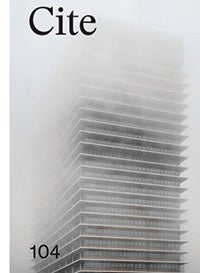A Permanent Record
Cite’s issue No. 104 reflects on 40 years of its own history — and of Houston’s many changes.

Winter 2024 | By Hilary C. Ritz
It’s highly unusual, to say the least, to hold a launch event for the publication of a single issue of a magazine. But Cite: The Architecture and Design Review of Houston is no usual magazine, and issue No. 104 is uncommon even for Cite, as it is the publication’s 40th anniversary issue. For those in the know, the event at Basket Books & Art last fall felt entirely earned.
“Cite has been the voice of Houston’s architecture and design community for four decades,” writes 104’s guest editor, Reto Geiser. “During this time, Houston has witnessed significant change … and Cite has been a trusted observer and commentator of this transformation. The magazine has created a permanent record of this city in which the states of decay and ascent are blurred.”
Those last few poetic words give you some sense of Cite. It’s a magazine that can’t be taken lightly, and not just because 104 clocks in at an astonishing 247 oversized pages. It’s chiefly because the magazine was created by Rice Design Alliance, which, as the community outreach arm for Rice’s School of Architecture, has the primary mission of design advocacy.

This focus is apparent on every page of the magazine, whether through its new (as of 2021) visual design, which merits the same time and attention as any worthwhile work of art, or the weightiness of its content. As School of Architecture Dean Igor Marjanović writes in his introductory letter, Cite has long captured the “ecological and urban friction” that is native to Houston.
Indeed, while the issue devotes 40-plus pages to its own 40 years of history — a fully forgivable choice for an anniversary issue — it spends well over a hundred pages tackling Houston’s economic inequalities, housing struggles amidst a growing population, how infrastructural systems shape the city, and more.
Cite may observe and offer critique of urban design, but it’s clear that part of its work is to foresee and even help shape Houston’s future. As Geiser writes, it is “critical to develop an image for what this city can be.” Cite’s contributions to that important task will surely continue to be remarkable.
